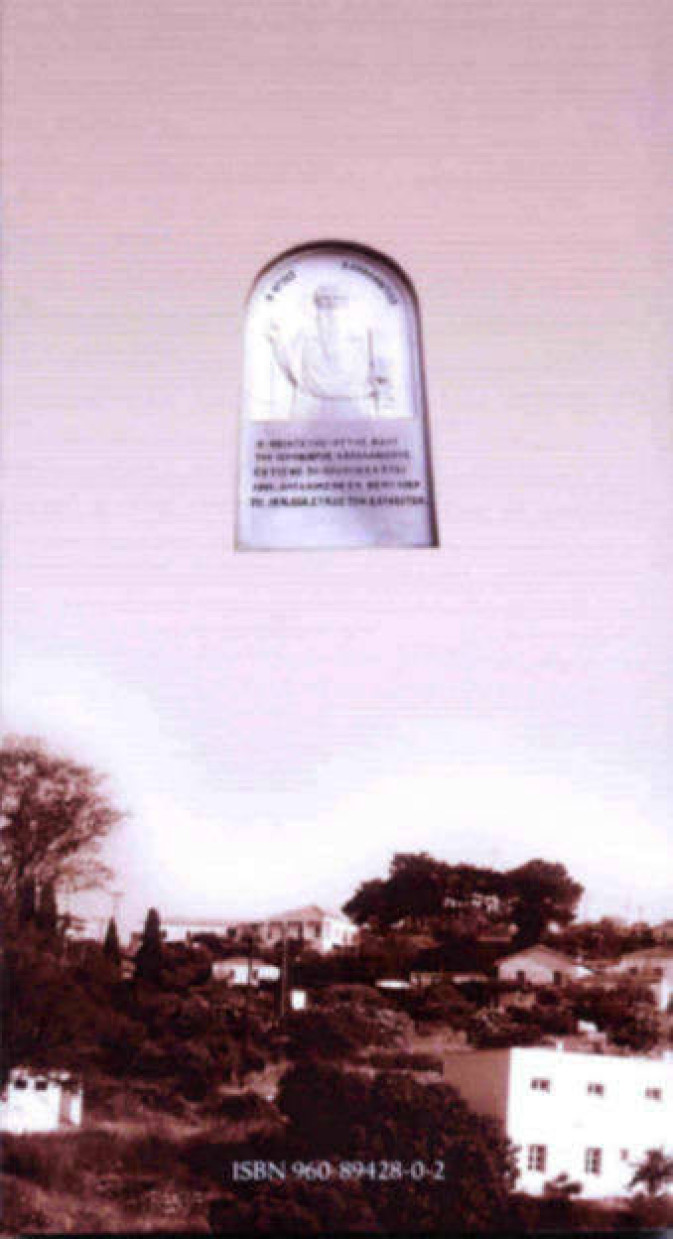History of Ayios Haralambos. Karavas, Kythera.
Back Cover
Author: Helen Haros-Coroneos
When Published: 2006
Publisher: Church Committee, Ayios Haralambos, Karavas, Kythera.
Printed: in Crete, www.kazanakis.gr
Available:
Description: Thin, small, 78 page book. Excellent photographs.
Language: GREEK.
Celebrating the Bicentennary of the creation of the fraternity that led to the building of the Church of Ayios Haralambos, Karavas, Kythera.
Prologue and Introduction in English. (Grammar and syntax errors retained).
P R 0 L 0 G U E
In the verdant picturesque and beautiful village of Kythera which is named Karavas, well known for its orange trees, its many springs and natural beauties as well as for its panoramic view to the island of Elafonissos and to the small city of Neapoli in the south of Peloponnisos, the historic majestic and imposing holy temple of Saint Charalampos surely dominates and has a principal position on this surrounding.
For a series of generations for the people of Karavas this temple has been a reference point and holy place from which life started, but, on the other hand the terrestrial life of these people ended. For the sad and for the good moments to the happy and unhappy personal family, social and national events the pious gentle and progressive people of Karavas considered and still do, after God and Virgin Mary, the temple of Saint Charalampos as their guardian and helper, something that they show by the beautiful fine and well looked after interior and exterior decoration of the holy temple where a lot of local festival and a number of happenings are held around it.
The assemblance and the recording of this rich historic material concerning the church of Saint Charalampos of Karavas and the writing of this book from the honourable Mrs Helen Haros-Coroneos an exceptional philologist and teacher of the Greek language, but also one of the greatest spiritual people of Kythera, constitutes for Caravas as well as for the island which belongs to Panayia Myrtidiotissa a notable and worth of congratulations event.
I consider it as my duty to deeply congratulate the active and constantly creative dean of the holy temple of Saint Charalampos father Panayiotis Diacopoulos and his progressive council of church for this initiation and impeccable collaboration with Mrs Haros.
Finally I paternally and whole heartedly wish that this book will help and contribute to the spiritual, cultural and touristic development of Cythera as there are a lot of primary needs that should be developed.
With warm fatherly wishes wholehearted congratulations and all my love.
The Bishop of Thessaliotidos
and Fanariofersallon
Cirillos (ex of Cythera)
I N T R 0 D U C T I 0 N
The completion of two centuries from the creation of the fraternity of Saint Charalampos in Caravas and the foundation of the homonymous temple was the tinder for the writing of this small essay.
It is well known that almost all the temples in Cythera were built by individuals and were used as family ones. A small number of temples were built by fraternities for the worship needs of their members such as the temple of Panayia Conteletou in Livadi, Saint Annas temple in Chora and Saint Charalambos in Caravas
It is easy to understand that the foundation of a temple from a fraternity in a remote village in Cythera 200 years ago has a major religious as well as social importance. The bond between the members of the fraternity, the harmonious collaboration and the noble emulation for the foundation and the distinction of their temple is a phenomenon worth to pay attention to and to be studied.
Beyond these, the formation of the fraternity and the foundation of the temple in Caravas introduces a great historic interest for the synthesis of the population and it also coincides with the period of huge political changes and the large movements of the population in Cythera.
The aim of this essay, even though there are a lot of imperfections for which I ask for your indulgence, is to shed light on the most beautiful period of the history of Caravas which is bound with the first years of the formation of the well organized settlements.
I owe a lot of thanks not only to the priest from Caravas, father Panayotis Diacopoulos for his valuable cooperation but also to the exceptional scientist and friend Manolis Dracacis, head of department of the General State Archives of the Heraclion, for his unquestionable willingness to assist me, his most important remarks as well as his valuable advice, which have improved the contents of the book. Finally, I thank the head of department of the Local Archives of Cythera Michael Megaloconomos, for its support in this effort that we've managed to accomplish, and Valerios Kalocherinos for the photo’s in this edition.
Helen Haros-Coroneos
Philologist of Local Archives of Cythera
